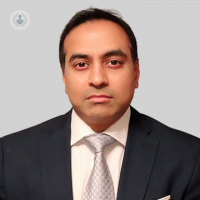Coronary heart disease: diagnosing and preventing the primary cause of death in the Western world
Autore:Coronary heart disease (CHD), also known as ischaemic heart disease, is the primary cause of death in the Western world. Dr Naveen Mudalagiri is an expert on the diagnosis and management of all types of heart disease. In this article, he explains the seriousness of CHD, symptoms and diagnosis. He also provides insight into two procedures for CHD: angiogram and angioplasty.

How vital is the heart?
The heart has a direct impact on every organ. It pumps blood to all tissues, providing oxygen and nutrients; both being vital for survival. The average heart bpm (beats per minute) is 72 and this occurs throughout your entire life. If the heart completely stops, death occurs within minutes. If the heart bpm falters, vital organs like the brain and kidneys suffer.
How common is coronary heart disease in the UK?
Around 73,000 people die of coronary heart disease each year in the UK. This is the cause of death for about one in six men and one in ten women. CHD is currently estimated to affect 2.3 million in the UK, with around two million people in the UK experiencing angina (the most common symptom of CHD).
What are symptoms of coronary heart disease?
Angina causes chest pain and/or tightness due to a restricted blood supply to the heart (caused by narrowed blood vessels). Think of this like a pressure sensation that can spread to your neck, your back and/or your jaw. Angina can be stable and only occur during specific moments (e.g. only during exercise) or angina can be unstable (e.g. it happens during moments of rest with minimal effort.
Unstable angina could be the beginning of a heart attack, which happens when blood stops flowing to the heart. It must be acted upon quickly to prevent irreversible damage to heart muscle and in even more serious cases, to prevent death.
How can coronary heart disease be prevented?
To minimise your risk of CHD, there are several lifestyle choices you can make:
- Minimise your intake of saturated fats and dairy.
- Avoid hydrogenated oils (these can result in trans fats that harm heart health).
- Make efforts where you can to maintain optimum body weight.
- Quit smoking.
- Exercise regularly.
- Regularly check your blood pressure to make sure it’s at an optimum level.
What tests diagnose coronary heart disease?
The first step when testing for coronary heart disease is to take a detailed history of the patient. The next step is to have a clinical examination. Following this, baseline blood tests are performed along with a lipid assessment (abnormal lipid levels in the blood can indicate coronary heart disease).
You might undergo one or more of the following imagining tests:
- Electrocardiogram (ECG)
- Chest X-ray
- Ultrasound scan ( echocardiogram ) of the heart
- CT scan (computerised tomography) – also known as CAT scan
- Cardiac MRI (magnetic resonance imaging)
You might also undergo a nuclear-based investigation. Nuclear based medicine involves using radioactive tracers to assess specific bodily functions and to diagnose conditions. It can also be used to treat some types of coronary heart disease.
A coronary angiogram can be used for further assessment, which provides a more thorough insight into the health of the heart’s arteries. A catheter (a small tube) is passed through the wrist or groin to the heart. A dye is passed into the heart arteries and x-ray imaging is used to view the anatomy of the heart. Angiogram is most often an outpatient procedure with patients receiving local anaesthetic.
What happens if narrowing of arteries is found?
Coronary angioplasty can be required when a narrowing of arteries has been diagnosed. In this procedure, a mini balloon is used to address the narrowing in the heart arteries via disobliteration (the process of removing a blockage in a blood vessel). Once the narrowing has been addressed and the blockage removed, a stent is then used to keep the artery open and restore blood flow to the heart. Stents can be covered in a special medication that prevents the artery from rapidly re-narrowing. Bio-absorbable stents slowly dissolve over 24 months.
Discover how Dr Mudalagiri’s can help you care for your heart health – visit his profile.


